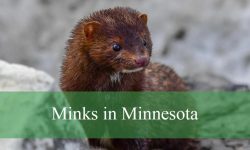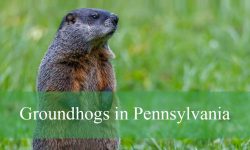Tiny red ants in North America are fascinating creatures that capture the curiosity of both scientists and nature enthusiasts.
In North America, several species of these ants can be found in diverse habitats, ranging from forests and grasslands to urban areas, with each species adapting uniquely to its surroundings.
Different Types of Tiny Red Ants
Florida Harvester Ant
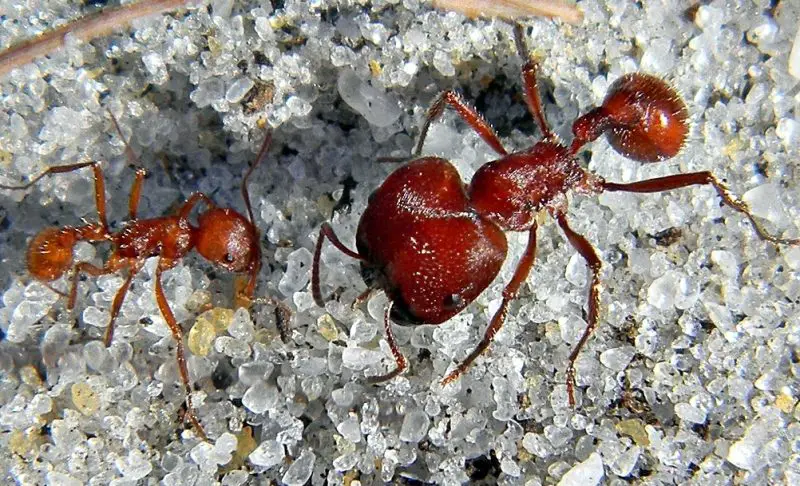
The Florida Harvester Ant (Pogonomyrmex badius), native to Florida, is a smaller and generally docile species compared to the larger Chestnut Carpenter Ants. Despite their usually passive nature, they can deliver a painful sting when provoked, injecting a potent venom that causes prolonged discomfort. These ants construct large mounds where they store seeds as food.
Their foraging behavior is extensive, often covering entire yards in search of sustenance. They use scent trails to resume their quest the following day. Unless their mounds are discovered in gardens, Florida Harvester Ants typically don’t require special management techniques.
Red Harvester Ant

Red Harvester Ants (Pogonomyrmex barbatus) are formidable insects inhabiting arid and desert regions. Known for their large underground nests, these ants fiercely defend their colonies with potent, venomous stings. Their venom, while highly dangerous, primarily targets natural predators like lizards.
Red Harvester Ants are efficient foragers, collecting seeds and insects to store in their nests. Human interactions with these ants can result in severe allergic reactions. Despite their defensive capabilities, the species faces declining numbers in some areas due to competition with other ant species for food resources.
Chestnut Carpenter Ant
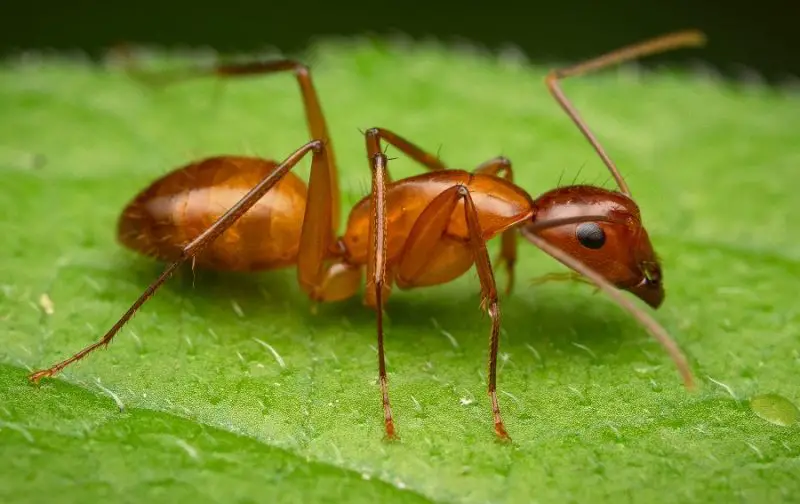
Chestnut Carpenter Ants (Camponotus castaneus) are prevalent in the Northern United States and Canada. Distinguished by their dark red coloration, these ants differ from their brighter Southern counterparts. Their darker hue is believed to aid in heat absorption from the sun, an adaptation to cooler northern climates.
These nocturnal foragers inhabit woodland areas, preferring to nest in ground-level wood, particularly in rotting logs that provide partial cover. The species also nests in soil, requiring high humidity for survival.
Red Imported Fire Ant
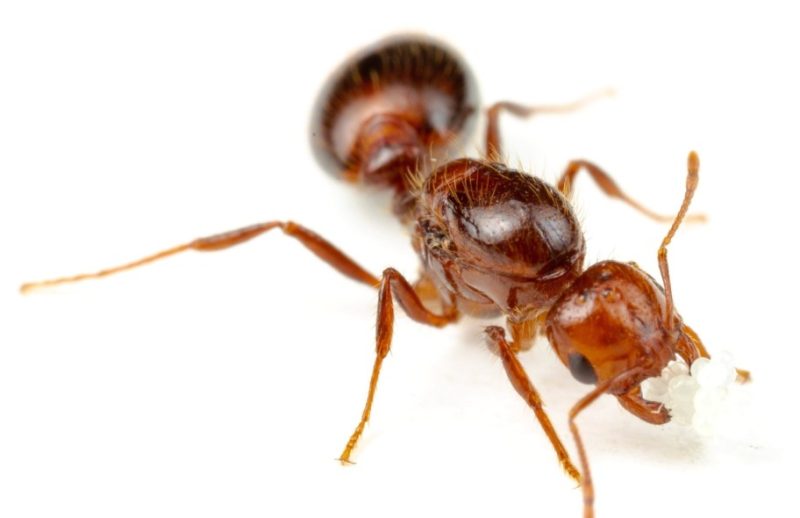
Red Imported Fire Ants (Solenopsis invicta) are among North America’s most dangerous biting ants. These aggressive insects fiercely defend their colonies, often established near human habitations in gardens, parks, pastures, and lawns. Their necrotoxic venom inflicts intensely painful stings, posing significant risks to children and pets.
Effective management is crucial due to its harmful nature. Successful control methods include injecting chemicals directly into mounds for rapid eradication and setting up baits around nests. Eliminating the queen is essential to preventing new colony formation.
The species’ adaptability and aggressive behavior make them a persistent threat, requiring vigilant monitoring and control measures to protect both human and animal populations in affected areas.
Apache Twig Ant
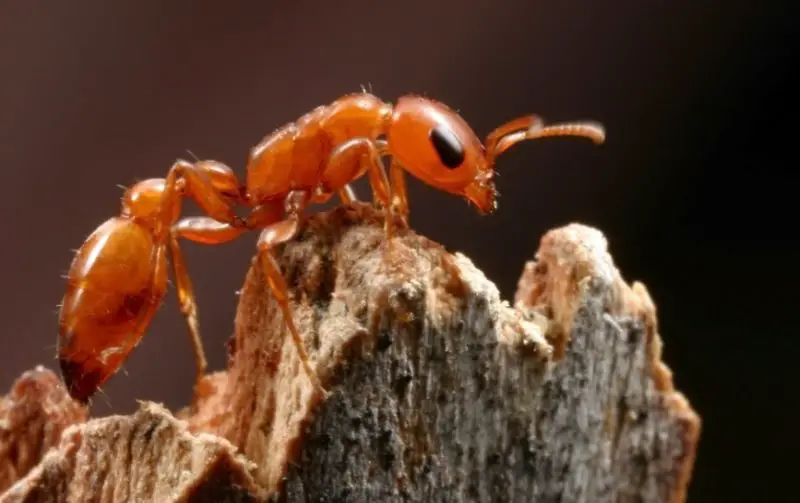
The Apache Twig Ant (Pseudomyrmex apache) is a distinctive species native to Southwestern North America, particularly along the West Coast. These ants, characterized by their yellow, orange, or orange-red coloration, prefer woodland habitats, especially those dominated by oak, mesquite, or juniper trees.
Uniquely, they nest in the dead areas of these trees, often utilizing pre-existing galleries created by wood-boring beetles rather than excavating their own.
This symbiotic relationship between the ants, beetles, and host trees creates a complex ecological interaction. The presence of both Apache Twig Ants and wood-boring beetles can potentially impact the health of local trees.
California Harvester Ant

The California Harvester Ant (Pogonomyrmex californicus) is a prevalent red ant species in the Southwestern United States. These diurnal ants primarily forage for seeds and insect larvae, particularly moths. They efficiently transport food back to their nests through well-defined entrances. Colonies, which can house hundreds of individuals, are typically small and may be led by a single queen or multiple queens working cooperatively.
These ants play a crucial role in seed dispersal and soil aeration. Easily identifiable by their reddish-brown color and moderate size (about 1/4 inch long), California Harvester Ants have a distinctively large head and powerful mandibles adapted for carrying seeds. Their nests often feature a circular clearing around the entrance, devoid of vegetation.
Southern Fire Ant
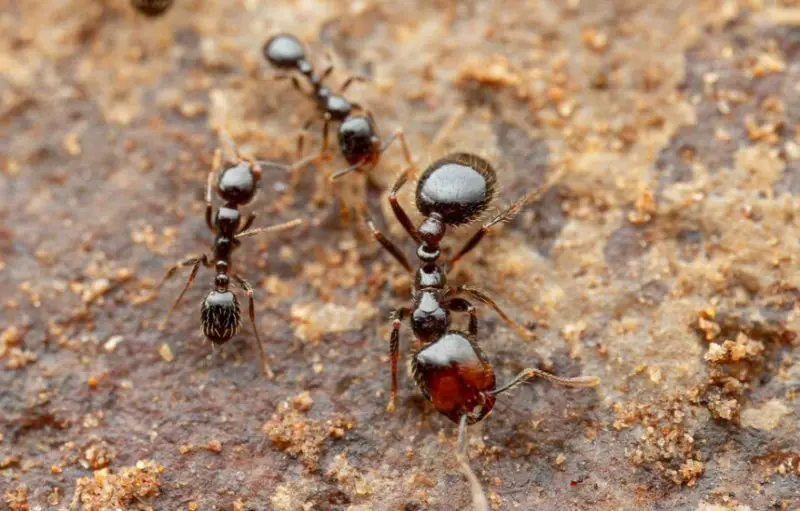
The Southern Fire Ant (Solenopsis xyloni) is a widely distributed species, ranging from California to North Carolina. Known for their aggressive nature, these ants fiercely defend their nests, often at the cost of their lives.
While their sting is painful, it’s generally considered less severe than that of Red Fire Ants. Southern Fire Ants are opportunistic feeders, foraging for various food sources to store in their nests. They particularly favor seeds, which are easy to transport.
Interestingly, these ants have also adapted to consume honeydew, often found on plants infested with aphids or other sap-sucking insects. Their colonies can be extensive, with multiple queens, allowing for rapid population growth and adaptability to diverse environments.
Desert Leaf-Cutter Ant

Desert Leaf-cutter Ants (Acromyrmex versicolor) are remarkable insects known for their unique foraging behavior. These dark red ants, with a rusty undertone, are adept at collecting and transporting leaf fragments back to their nests for food. Their adaptability is evident in their ability to thrive in diverse environments, from areas with lush green vegetation to arid desert scrublands with only dry plant matter.
This versatility in foraging habits, encompassing both humid and dry locations, has contributed to their stable population in North America. The species plays a crucial role in ecosystem dynamics, influencing plant distribution and soil composition through their leaf-cutting and nest-building activities.
Pallid Twig Ant
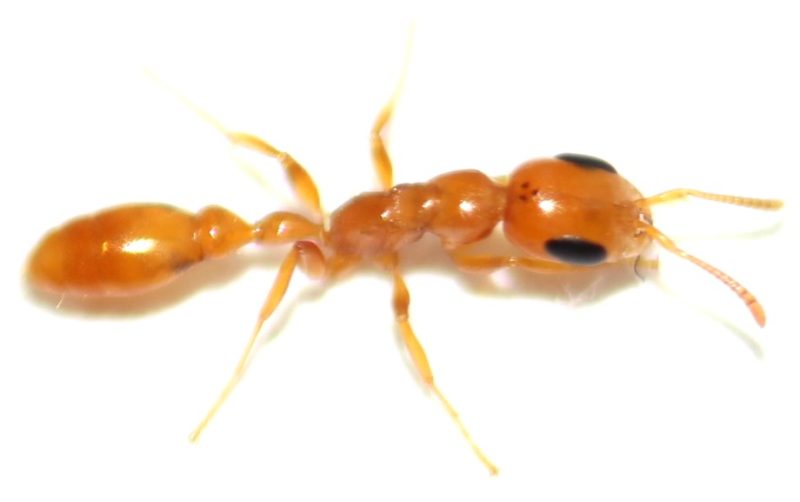
Pallid Twig Ants (Pseudomyrmex pallidus) are unique insects with distinctive feeding and nesting habits. These ants primarily consume nectar and both living and dead insects. Interestingly, they don’t store food in their nests for personal consumption. Instead, all pollen and insects brought back to the nest are exclusively used to feed their larvae.
Pallid Twig Ants exhibit remarkable nesting behavior, preferring to establish their colonies in the stems of dead plants. They expertly hollow out these stems to create chambers for their larvae, with some of the largest excavated dry-stem nests reaching impressive lengths of up to 20 inches.
This adaptive nesting strategy allows them to thrive in various environments while providing optimal protection for their developing offspring.
Navigating Big-Headed Ants

Navigating Big-headed Ants (Pheidole navigans) are prevalent in Southern states and Hawaii. These dark red ants are known for their swarming behavior, often causing alarm due to their shared habitat with termites, leading to frequent misidentification.
While primarily outdoor dwellers, they occasionally venture indoors as mild pests, attracted by open food sources, particularly sugary items and meat. Their presence in homes is often linked to accessible food. The species’ name reflects their notable head size, a characteristic feature of the genus Pheidole.
Northern Fungus-Farming Ant
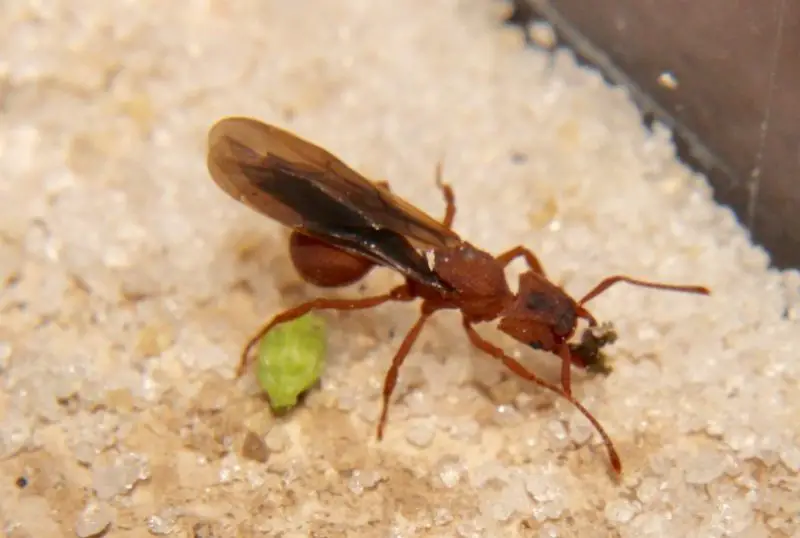
Northern Fungus-farming Ants (Trachymyrmex septentrionalis), despite their name, are predominantly found in Southern U.S. territories. These dark red or red-brown ants thrive in Southeastern plains, including Florida, and are also abundant in California. Preferring arid, sandy soils, they construct their nests underground.
The species is known for its aggressive behavior towards perceived threats approaching their colonies. Their most distinctive trait is their fungus-farming habit of cultivating fungus gardens within their nests for food. This symbiotic relationship with fungi allows them to thrive in diverse environments.
Larger Citronella Ant

Larger Citronella Ants (Lasius interjectus) are distinctive insects known for their bright red or red-to-orange coloration. These ants construct both surface mounds and subterranean nests, showcasing their adaptability. Their name derives from the citrus-like odor they emit when their nest is threatened, a unique defensive mechanism.
Notably, Larger Citronella Ants are parasites, often nesting alongside other subterranean species, particularly the Smaller Yellow Ants (Lasius claviger) in the United States. This parasitic behavior necessitates specific management techniques for effective control.
Tennessee Thread-Waisted Ant
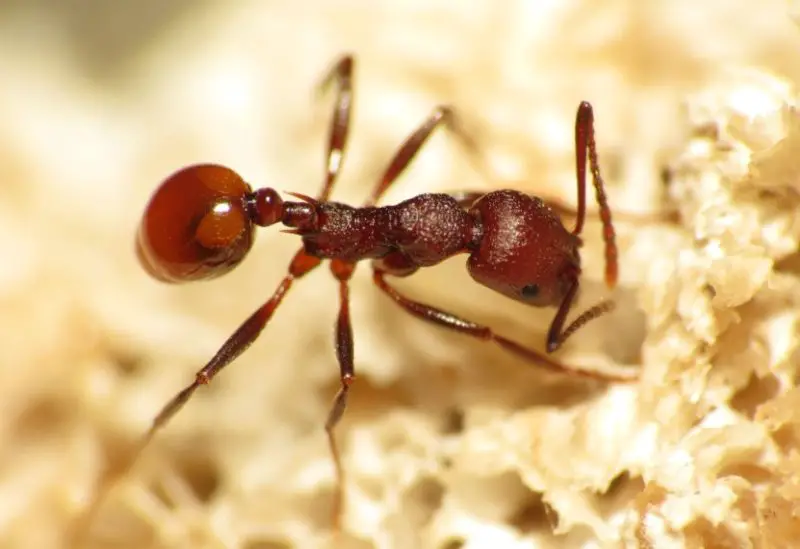
The Tennessee Thread-waisted Ant (Aphaenogaster tennesseensis) is a unique species native to Southeastern US habitats. These diminutive dark-red ants are among the smallest in the region, distinguished by their parasitic lifestyle. Remarkably, they infiltrate and occupy the nests of other Aphaenogaster species, demonstrating a fascinating form of social parasitism.
Their diet is strictly carnivorous, setting them apart from many of their ant counterparts. This specialized feeding habit, combined with their parasitic nature, makes the Tennessee Thread-waisted Ant an intriguing subject for myrmecologists.
Comanche Harvester Ant
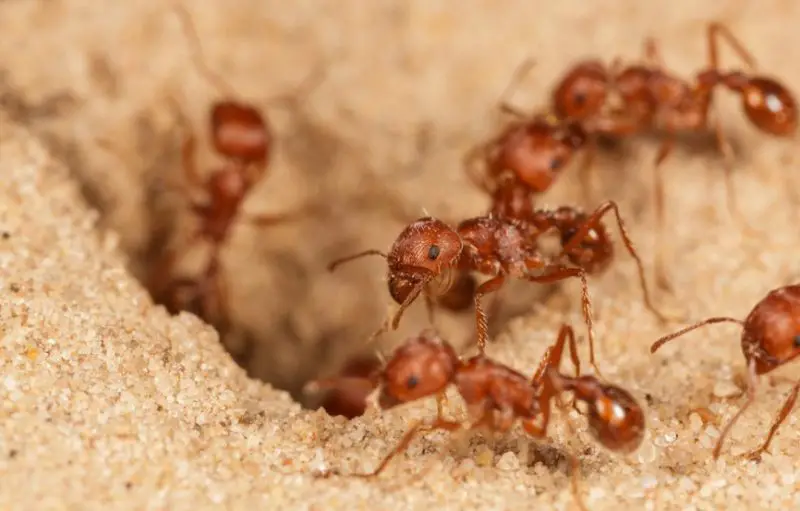
The Comanche Harvester Ant (Pogonomyrmex comanche) is a distinctive species found in Arkansas, Texas, and Louisiana. Despite their limited numbers, which prevent them from being considered a major pest, these ants are notorious for their extremely painful sting, ranking among the most severe of North American red ants.
Comanche Harvester Ants exhibit highly aggressive behavior when their underground nests are threatened. These colonies, though sometimes small in surface appearance, can house thousands of individuals and extend several feet below ground.
Bilimek’s Big-Headed Ant
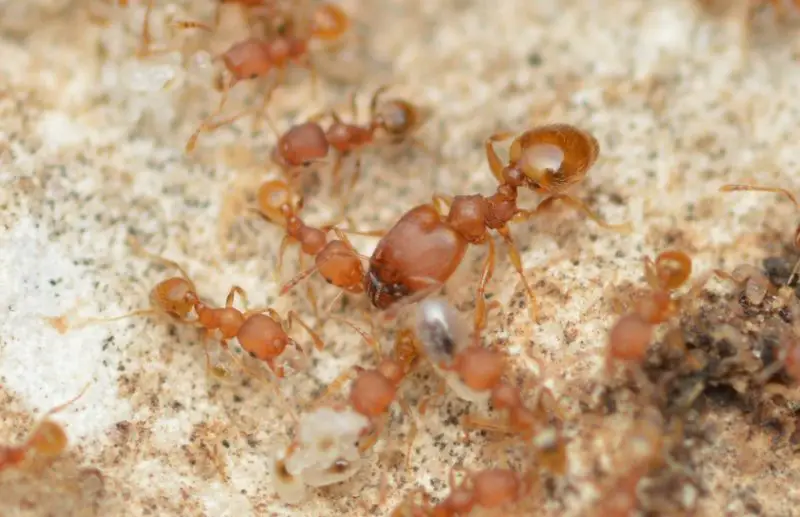
Bilimek’s Big-Headed Ant (Pheidole bilimeki) is a widespread species native to tropical regions, ranging from Costa Rica to the United States. These ants are notorious pests in their habitats, frequently invading homes in search of food. Their painful sting makes them challenging to remove safely, posing a significant nuisance to homeowners.
Bilimek’s Big-Headed Ants typically nest under rocks and logs near houses, complicating eradication efforts. Effective control often requires eliminating nearby nests. Their adaptability to various environments and proximity to human dwellings make them a persistent problem in affected areas.

